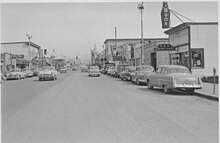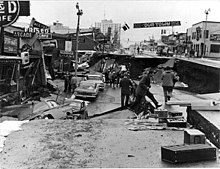Quick Stats
Population in 2011: 293,356. Population change since 2000: +12.7%
 |
| Males: 148,986 | |
| Females: 144,370 |
| Median resident age: | |
| Alaska median age: |
http://www.city-data.com/city/Anchorage-Alaska.html#ixzz2NCUEf42L
Russian presence in south central Alaska was well established in the 19th century. In 1867, U. S. Secretary of State William H. Seward brokered a deal to purchase Alaskafrom an Imperial Russia for $7.2 million (about two cents an acre). The deal was lampooned by political rivals as "Seward's folly", "Seward's icebox" and "Walrussia". By 1888, gold was discovered along Turnagain Arm.
In 1912, Alaska became a United States territory. Anchorage, unlike every other large town in Alaska south of the Brooks Range, was neither a fishing nor mining camp. The area within tens of miles of Anchorage is barren of significant economic metal minerals. While a number of Dena'ina settlements existed along Knik Arm for years, only twowhite men, Bud Whitney and Jack Brown, were reported to have lived in the Ship Creekvalley in the 1910s prior to the large influx of settlers.
The city grew from its happenstance choice as the site, in 1914, of a railroadconstruction port for the Alaska Engineering Commission. Construction of the railroad, to be known as the Alaska Railroad, continued until its completion in 1923. The area near the mouth of Ship Creek, where the railroad headquarters was located, quickly became a tent city. A town site was mapped out on higher ground to the south of the tent city, greatly noted in the years since for its order and rigidity compared with other Alaska town sites. Anchorage was incorporated on November 23, 1920.[5]
The city's economy in the 1920s and 1930s centered on the railroad. Col. Otto F. Ohlson, the Swedish-born general manager of the railroad for nearly two decades, became a symbol of residents' contempt for the firm control he maintained over the railroad's affairs, which by extension became control over economic and other aspects of life in Alaska.
Between the 1930s and the 1950s, the city experienced massive growth as air transportation and the military became increasingly important. Aviation operations in Anchorage commenced along the firebreak south of town (today's Delaney Park Strip), which was also used by residents as a golf course. An increase in air traffic led to clearing of a site directly east of town site boundaries starting in 1929, which became Merrill Field. Merrill Field served as Anchorage's primary airport during the 1930s and 1940s, when it was replaced by Anchorage International Airport upon its opening in 1951. Merrill Field still serves a significant amount of general aviation traffic to this day.
Elmendorf Air Force Base and Fort Richardson were constructed in the 1940s, and served as the city's primary economic engine until the 1968 Prudhoe Bay discoveryshifted the thrust of the economy toward the oil industry. The 2005 Base Realignment and Closure process led to the combining of the two bases (along with Kulis Air National Guard Base) to form Joint Base Elmendorf-Richardson.
On March 27, 1964, Anchorage was hit by the magnitude 9.2 Good Friday Earthquake, which killed 115 people and caused $311 million ($2.33 billion current value)[6] in damage.[7][8] The earth-shaking event lasted nearly five minutes; most structures that failed remained intact the first few minutes, then failed with repeated flexing.[7][8] It was the second largest earthquake in the recorded history of the world.[7][8] Rebuilding dominated the remainder of the 1960s.
In 1968, oil was discovered in Prudhoe Bay, and the resulting oil boom spurred further growth in Anchorage. In 1975, the City of Anchorage and the Greater Anchorage Area Borough (which includes Eagle River, Girdwood, Glen Alps, and several other communities) merged into the geographically larger Municipality of Anchorage.[5] The city continued to grow in the 1980s, and capital projects and an aggressive beautification campaign took place. (http://en.wikipedia.org/wiki/Anchorage,_Alaska)





No comments:
Post a Comment